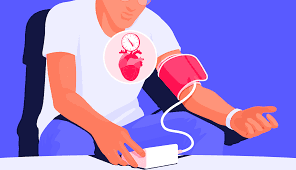How to Lower Blood Pressure: A Comprehensive Guide
High blood pressure, or hypertension, is a common health condition affecting millions worldwide. Often called the “silent killer,” it can lead to serious health issues like heart disease, stroke, and kidney problems. Fortunately, there are numerous strategies to help lower blood pressure and improve overall health. This article provides a comprehensive guide to understanding blood pressure and effective methods to manage it.
Understanding Blood Pressure
Blood pressure is the force of blood against the walls of your arteries. It is measured in millimeters of mercury (mmHg) and is expressed as two numbers: systolic (the pressure during heartbeats) and diastolic (the pressure between beats). A normal blood pressure reading is generally around 120/80 mmHg. Readings above this range can indicate varying levels of hypertension:
- Elevated: 120-129 systolic and less than 80 diastolic
- Hypertension Stage 1: 130-139 systolic or 80-89 diastolic
- Hypertension Stage 2: 140 or higher systolic or 90 or higher diastolic
Why Managing Blood Pressure is Important
Managing blood pressure is crucial because prolonged hypertension can damage blood vessels, leading to complications such as:
- Heart Disease: Increased workload on the heart can lead to heart failure.
- Stroke: High blood pressure can cause blood vessels in the brain to burst or become blocked.
- Kidney Damage: Hypertension can damage the kidneys’ filtering system.
- Vision Loss: High blood pressure can strain the vessels in the eyes, leading to vision problems.
Lifestyle Changes to Lower Blood Pressure
1. Healthy Diet
Diet plays a significant role in managing blood pressure. The DASH Diet (Dietary Approaches to Stop Hypertension) emphasizes whole foods, including:
- Fruits and Vegetables: Aim for at least five servings a day to provide essential vitamins and minerals.
- Whole Grains: Opt for whole grain bread, brown rice, and oatmeal instead of refined grains.
- Lean Proteins: Include sources like chicken, fish, legumes, and nuts.
- Low-Fat Dairy: Choose low-fat or fat-free options to reduce saturated fat intake.
- Limit Sodium: Aim for less than 2,300 mg per day; ideally, reduce it to 1,500 mg for greater blood pressure control.
2. Regular Physical Activity
Engaging in regular physical activity can significantly lower blood pressure. Aim for at least 150 minutes of moderate aerobic exercise each week, such as brisk walking, cycling, or swimming. Resistance training twice a week can also be beneficial. Exercise helps maintain a healthy weight and strengthens the heart, allowing it to pump blood more efficiently.
3. Weight Management
Carrying excess weight puts additional strain on the heart and can raise blood pressure. Losing even a small amount of weight (5-10% of your body weight) can make a significant difference. Focus on sustainable weight loss through balanced eating and regular exercise.
4. Limit Alcohol Consumption
Excessive alcohol intake can raise blood pressure. It’s recommended to limit alcohol to moderate levels:
- Women: Up to one drink per day
- Men: Up to two drinks per day
5. Quit Smoking
Smoking contributes to high blood pressure and damages blood vessels. Quitting smoking can improve overall cardiovascular health and help lower blood pressure. Seek support from healthcare providers or cessation programs if needed.
6. Manage Stress
Chronic stress may contribute to hypertension. To manage stress effectively:
- Practice Mindfulness: Techniques such as meditation, yoga, or deep breathing can help calm the mind and reduce stress.
- Engage in Hobbies: Activities that you enjoy can provide a mental break and lower stress levels.
- Connect with Others: Spending time with friends and family can be a great stress reliever.
7. Get Enough Sleep
Poor sleep quality can adversely affect blood pressure. Aim for 7-9 hours of quality sleep each night. Establish a relaxing bedtime routine, create a comfortable sleep environment, and limit exposure to screens before bed.
Natural Supplements and Remedies
While lifestyle changes are the foundation for managing blood pressure, certain natural supplements may also help. Always consult a healthcare provider before starting any new supplement.
1. Omega-3 Fatty Acids
Found in fish oil, omega-3 fatty acids can reduce inflammation and improve heart health. Consider including fatty fish in your diet or taking fish oil supplements.
2. Coenzyme Q10 (CoQ10)
CoQ10 is an antioxidant that may help lower blood pressure. Some studies suggest it can improve endothelial function and reduce arterial stiffness.
3. Magnesium
Magnesium helps regulate blood pressure. Foods high in magnesium include leafy greens, nuts, seeds, and whole grains. Supplements may also be beneficial for those with low magnesium levels.
4. Potassium
Potassium helps balance sodium levels in the body. Foods rich in potassium include bananas, oranges, potatoes, and spinach. Consider increasing potassium intake as long as kidney function is normal.
5. Beetroot Juice
Some studies indicate that beetroot juice may help lower blood pressure due to its high nitrate content, which can relax blood vessels and improve blood flow.
Medical Interventions
In some cases, lifestyle changes alone may not be enough to manage high blood pressure. Your healthcare provider may prescribe medications such as:
- Diuretics: Help eliminate excess sodium and water.
- ACE Inhibitors: Relax blood vessels by blocking a hormone that narrows them.
- Beta-Blockers: Reduce heart rate and the heart’s workload.
- Calcium Channel Blockers: Relax the muscles of the blood vessels.
It’s essential to follow your doctor’s advice and regularly monitor your blood pressure to determine the effectiveness of your treatment plan.
Conclusion
Lowering blood pressure is a multifaceted approach that combines lifestyle changes, dietary modifications, stress management, and, when necessary, medication. By adopting a healthier lifestyle and seeking regular medical advice, you can effectively manage your blood pressure and reduce your risk of serious health complications. Remember that small changes can lead to significant improvements, so start with one or two strategies and gradually incorporate more over time. Your heart will thank you!
Thanks for visiting Gymbag4u.com
You may also love reading our following articles. https://gymbag4u.com/allergy-symptoms-a-comprehensive-guide/ and https://gymbag4u.com/what-is-rsv-respiratory-syncytial-virus-and-its-remedies/ and https://gymbag4u.com/is-pneumonia-contagious-understanding-the-risks-and-prevention/ and https://gymbag4u.com/high-blood-pressure-symptoms-causes-and-remedies/ and https://gymbag4u.com/flu-symptoms-and-remedies-your-essential-guide/ and https://gymbag4u.com/lower-blood-pressure-how-to-follow-the-natural-way/
